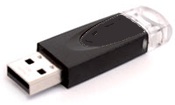![]()
 |
 |
 |
 |
 |
With the common administrative group (one PED Key accesses multiple HSMs) – as opposed to the default unique secret (where each HSM has its own unique PED Key) – you can use numerous HSMs and not need to manage numerous keys.
For example, at an installation employing five Luna HSMs:
compared to
During the process of initializing an HSM, or creating an HSM Partition (on Luna HSM with PED [Trusted Path] Authentication), Luna PED attempts to imprint a blue or a black or a red , and asks:
Do you wish to reuse an existing keyset?

 In other words, saying "YES" to the PED prompt "Do you wish to reuse an existing keyset", is the method to share a common authentication secret among multiple HSMs.
In other words, saying "YES" to the PED prompt "Do you wish to reuse an existing keyset", is the method to share a common authentication secret among multiple HSMs.
Alternatively, if you wish to have different PED Keys associated with each HSM in your possession, answer 'NO'. A 'NO', is a choice to overwrite the PIN (if one is already present) and store a new, randomly-generated PIN on this PED Key – any existing authentication code on this PED Key is to be overwritten with a new code, good with only the current HSM or token. The same applies to black HSM Partition User PED Keys.
 The red PED Keys must have
the same domain secret for each HSM that will synchronize (backup and restore, or HA)
with another. An HSM backup partition or token content can be restored only onto
an HSM that was initialized with the same red key secret. You must always choose to "...reuse an existing keyset" when initializing any HSM after the first one in a cloning group, or any partition after the first one in a cloning group.
The red PED Keys must have
the same domain secret for each HSM that will synchronize (backup and restore, or HA)
with another. An HSM backup partition or token content can be restored only onto
an HSM that was initialized with the same red key secret. You must always choose to "...reuse an existing keyset" when initializing any HSM after the first one in a cloning group, or any partition after the first one in a cloning group.
 The orange RPK PED Key, for RPV (Remote PED Vector), carries a secret that matches the RPV on an HSM to which you will be remotely authenticating with Luna PED 2 remote version. If you wish more than one HSM to have the same RPK, then you would choose to "...reuse an existing keyset" when setting RPK with "hsm ped vector init".
The orange RPK PED Key, for RPV (Remote PED Vector), carries a secret that matches the RPV on an HSM to which you will be remotely authenticating with Luna PED 2 remote version. If you wish more than one HSM to have the same RPK, then you would choose to "...reuse an existing keyset" when setting RPK with "hsm ped vector init".
 The white Audit PED Key carries the secret that authenticates the holder of the Audit role for the current HSM, and for any other HSMs where you have chosen to "Reuse" the PED Key when initializing the Audit role.
The white Audit PED Key carries the secret that authenticates the holder of the Audit role for the current HSM, and for any other HSMs where you have chosen to "Reuse" the PED Key when initializing the Audit role.
Reusing a PED Key forces all PED PINS to be the same
 The purple SRK PED Key differs from the others, in that it cannot be used with more than one HSM in common. You can reuse a purple PED Key with a different HSM by overwriting the key, but you cannot reuse the secret on that key with any HSM other than the one that originated the secret. The SRV (secure recovery vector) is not transferable. Each SRV is unique. An HSM can export a split of its SRV onto a purple PED Key (SRK) for use with only that HSM. If you imprint a valid purple PED Key with any other HSM, the key takes on a new SRV split that is valid with the new HSM, and is no longer useful with the original HSM.
The purple SRK PED Key differs from the others, in that it cannot be used with more than one HSM in common. You can reuse a purple PED Key with a different HSM by overwriting the key, but you cannot reuse the secret on that key with any HSM other than the one that originated the secret. The SRV (secure recovery vector) is not transferable. Each SRV is unique. An HSM can export a split of its SRV onto a purple PED Key (SRK) for use with only that HSM. If you imprint a valid purple PED Key with any other HSM, the key takes on a new SRV split that is valid with the new HSM, and is no longer useful with the original HSM.